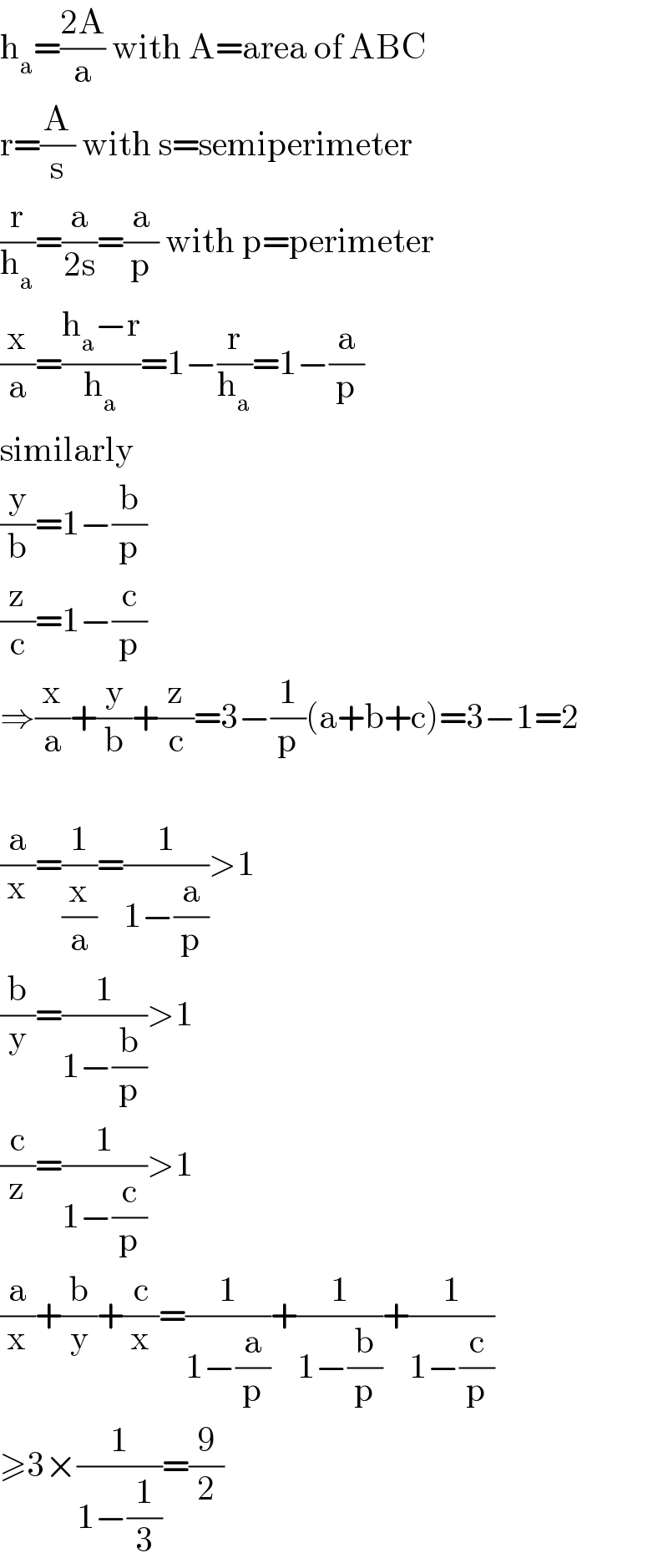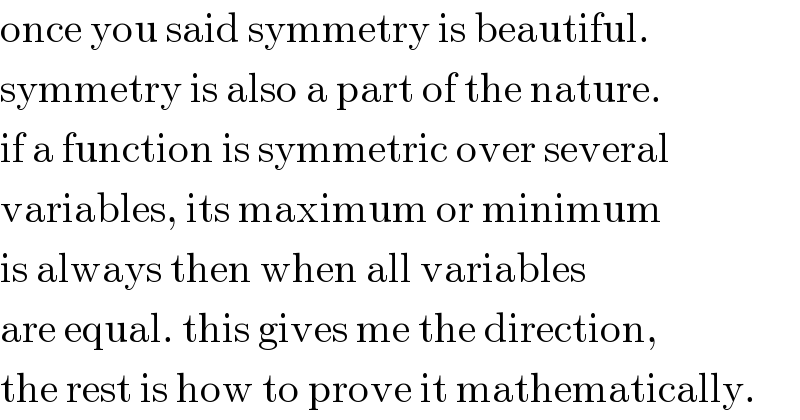
Question Number 15700 by b.e.h.i.8.3.4.1.7@gmail.com last updated on 12/Jun/17

Commented by b.e.h.i.8.3.4.1.7@gmail.com last updated on 13/Jun/17

$${j},{is}\:{the}\:{incircle}\:{of}\:{A}\overset{\Delta} {{B}C}. \\ $$$${MN}\parallel{AC},{KL}\parallel{AB},{OP}\parallel{BC} \\ $$$${OP}={x},{MN}={y},{KL}={z},{AB}={c},{BC}={a},{AC}={b}. \\ $$$${a}>{b}>{c}>\mathrm{1} \\ $$$$......................................................... \\ $$$${show}\:{that}: \\ $$$$\left.\mathrm{1}\right)\frac{\boldsymbol{{x}}}{\boldsymbol{{a}}}+\frac{\boldsymbol{{y}}}{\boldsymbol{{b}}}+\frac{\boldsymbol{{z}}}{\boldsymbol{{c}}}=\mathrm{2} \\ $$$$\left.\mathrm{2}\right)\frac{\boldsymbol{{a}}}{\boldsymbol{{x}}}+\frac{\boldsymbol{{b}}}{\boldsymbol{{y}}}+\frac{\boldsymbol{{c}}}{\boldsymbol{{z}}}\geqslant\frac{\mathrm{9}}{\mathrm{2}} \\ $$
Answered by mrW1 last updated on 13/Jun/17

$$\mathrm{h}_{\mathrm{a}} =\frac{\mathrm{2A}}{\mathrm{a}}\:\mathrm{with}\:\mathrm{A}=\mathrm{area}\:\mathrm{of}\:\mathrm{ABC} \\ $$$$\mathrm{r}=\frac{\mathrm{A}}{\mathrm{s}}\:\mathrm{with}\:\mathrm{s}=\mathrm{semiperimeter} \\ $$$$\frac{\mathrm{r}}{\mathrm{h}_{\mathrm{a}} }=\frac{\mathrm{a}}{\mathrm{2s}}=\frac{\mathrm{a}}{\mathrm{p}}\:\mathrm{with}\:\mathrm{p}=\mathrm{perimeter} \\ $$$$\frac{\mathrm{x}}{\mathrm{a}}=\frac{\mathrm{h}_{\mathrm{a}} −\mathrm{r}}{\mathrm{h}_{\mathrm{a}} }=\mathrm{1}−\frac{\mathrm{r}}{\mathrm{h}_{\mathrm{a}} }=\mathrm{1}−\frac{\mathrm{a}}{\mathrm{p}} \\ $$$$\mathrm{similarly} \\ $$$$\frac{\mathrm{y}}{\mathrm{b}}=\mathrm{1}−\frac{\mathrm{b}}{\mathrm{p}} \\ $$$$\frac{\mathrm{z}}{\mathrm{c}}=\mathrm{1}−\frac{\mathrm{c}}{\mathrm{p}} \\ $$$$\Rightarrow\frac{\mathrm{x}}{\mathrm{a}}+\frac{\mathrm{y}}{\mathrm{b}}+\frac{\mathrm{z}}{\mathrm{c}}=\mathrm{3}−\frac{\mathrm{1}}{\mathrm{p}}\left(\mathrm{a}+\mathrm{b}+\mathrm{c}\right)=\mathrm{3}−\mathrm{1}=\mathrm{2} \\ $$$$ \\ $$$$\frac{\mathrm{a}}{\mathrm{x}}=\frac{\mathrm{1}}{\frac{\mathrm{x}}{\mathrm{a}}}=\frac{\mathrm{1}}{\mathrm{1}−\frac{\mathrm{a}}{\mathrm{p}}}>\mathrm{1} \\ $$$$\frac{\mathrm{b}}{\mathrm{y}}=\frac{\mathrm{1}}{\mathrm{1}−\frac{\mathrm{b}}{\mathrm{p}}}>\mathrm{1} \\ $$$$\frac{\mathrm{c}}{\mathrm{z}}=\frac{\mathrm{1}}{\mathrm{1}−\frac{\mathrm{c}}{\mathrm{p}}}>\mathrm{1} \\ $$$$\frac{\mathrm{a}}{\mathrm{x}}+\frac{\mathrm{b}}{\mathrm{y}}+\frac{\mathrm{c}}{\mathrm{x}}=\frac{\mathrm{1}}{\mathrm{1}−\frac{\mathrm{a}}{\mathrm{p}}}+\frac{\mathrm{1}}{\mathrm{1}−\frac{\mathrm{b}}{\mathrm{p}}}+\frac{\mathrm{1}}{\mathrm{1}−\frac{\mathrm{c}}{\mathrm{p}}} \\ $$$$\geqslant\mathrm{3}×\frac{\mathrm{1}}{\mathrm{1}−\frac{\mathrm{1}}{\mathrm{3}}}=\frac{\mathrm{9}}{\mathrm{2}} \\ $$
Commented by b.e.h.i.8.3.4.1.7@gmail.com last updated on 13/Jun/17

$${thanks}\:{for}\:{your}\:{care}.\:{errorfixed}. \\ $$
Commented by ajfour last updated on 13/Jun/17

$$\:\:\:\:\:\:\frac{{a}}{{p}}\geqslant\frac{\mathrm{1}}{\mathrm{3}}\:\left(\:{Sir},\:{some}\:{proof}\:{please}\right). \\ $$
Commented by mrW1 last updated on 13/Jun/17

$$\mathrm{I}\:\mathrm{didn}'\mathrm{t}\:\mathrm{mean}\:\mathrm{that}\:\frac{\mathrm{a}}{\mathrm{p}}\geqslant\frac{\mathrm{1}}{\mathrm{3}},\:\mathrm{but}\:\mathrm{I}\:\mathrm{mean} \\ $$$$\mathrm{minimum}\:\mathrm{for}\:\frac{\mathrm{1}}{\mathrm{1}−\frac{\mathrm{a}}{\mathrm{p}}}+\frac{\mathrm{1}}{\mathrm{1}−\frac{\mathrm{b}}{\mathrm{p}}}+\frac{\mathrm{1}}{\mathrm{1}−\frac{\mathrm{c}}{\mathrm{p}}}\:\mathrm{is} \\ $$$$\frac{\mathrm{9}}{\mathrm{2}}\:\mathrm{when}\:\frac{\mathrm{a}}{\mathrm{p}}=\frac{\mathrm{b}}{\mathrm{p}}=\frac{\mathrm{c}}{\mathrm{p}}=\frac{\mathrm{1}}{\mathrm{3}}. \\ $$$$ \\ $$$$\mathrm{Here}\:\mathrm{is}\:\mathrm{the}\:\mathrm{proof}: \\ $$$$\mathrm{let}\:\mathrm{x}=\frac{\mathrm{a}}{\mathrm{p}},\:\mathrm{y}=\frac{\mathrm{b}}{\mathrm{p}},\mathrm{z}=\frac{\mathrm{c}}{\mathrm{p}} \\ $$$$\mathrm{x}+\mathrm{y}+\mathrm{z}=\mathrm{1} \\ $$$$\frac{\mathrm{1}}{\mathrm{1}−\frac{\mathrm{a}}{\mathrm{p}}}+\frac{\mathrm{1}}{\mathrm{1}−\frac{\mathrm{b}}{\mathrm{p}}}+\frac{\mathrm{1}}{\mathrm{1}−\frac{\mathrm{c}}{\mathrm{p}}}\:=\frac{\mathrm{1}}{\mathrm{1}−\mathrm{x}}+\frac{\mathrm{1}}{\mathrm{1}−\mathrm{y}}+\frac{\mathrm{1}}{\mathrm{1}−\mathrm{z}} \\ $$$$=\frac{\mathrm{1}}{\mathrm{1}−\mathrm{x}}+\frac{\mathrm{1}}{\mathrm{1}−\mathrm{y}}+\frac{\mathrm{1}}{\mathrm{x}+\mathrm{y}}=\mathrm{f}\left(\mathrm{x},\mathrm{y}\right) \\ $$$$\frac{\partial\mathrm{f}}{\partial\mathrm{x}}=\frac{\mathrm{1}}{\left(\mathrm{1}−\mathrm{x}\right)^{\mathrm{2}} }−\frac{\mathrm{1}}{\left(\mathrm{x}+\mathrm{y}\right)^{\mathrm{2}} } \\ $$$$\frac{\partial\mathrm{f}}{\partial\mathrm{y}}=\frac{\mathrm{1}}{\left(\mathrm{1}−\mathrm{y}\right)^{\mathrm{2}} }−\frac{\mathrm{1}}{\left(\mathrm{x}+\mathrm{y}\right)^{\mathrm{2}} } \\ $$$$ \\ $$$$\mathrm{f}\left(\mathrm{x},\mathrm{y}\right)\:\mathrm{is}\:\mathrm{minimum}\:\mathrm{when}\:\frac{\partial\mathrm{f}}{\partial\mathrm{x}}=\mathrm{0}\:\mathrm{and}\:\frac{\partial\mathrm{f}}{\partial\mathrm{y}}=\mathrm{0} \\ $$$$\frac{\partial\mathrm{f}}{\partial\mathrm{x}}=\frac{\mathrm{1}}{\left(\mathrm{1}−\mathrm{x}\right)^{\mathrm{2}} }−\frac{\mathrm{1}}{\left(\mathrm{x}+\mathrm{y}\right)^{\mathrm{2}} }=\mathrm{0} \\ $$$$\Rightarrow\mathrm{1}−\mathrm{x}=\mathrm{x}+\mathrm{y}\:\:\:\:...\left(\mathrm{i}\right) \\ $$$$ \\ $$$$\frac{\partial\mathrm{f}}{\partial\mathrm{y}}=\frac{\mathrm{1}}{\left(\mathrm{1}−\mathrm{y}\right)^{\mathrm{2}} }−\frac{\mathrm{1}}{\left(\mathrm{x}+\mathrm{y}\right)^{\mathrm{2}} }=\mathrm{0} \\ $$$$\Rightarrow\mathrm{1}−\mathrm{y}=\mathrm{x}+\mathrm{y}\:\:\:\:...\left(\mathrm{ii}\right) \\ $$$$ \\ $$$$\mathrm{from}\:\left(\mathrm{i}\right)\:\mathrm{and}\:\left(\mathrm{ii}\right) \\ $$$$\mathrm{x}=\mathrm{y}=\frac{\mathrm{1}}{\mathrm{3}} \\ $$$$\mathrm{z}=\mathrm{1}−\left(\mathrm{x}+\mathrm{y}\right)=\frac{\mathrm{1}}{\mathrm{3}} \\ $$$$\mathrm{f}\left(\mathrm{x},\mathrm{y}\right)_{\mathrm{min}.} =\mathrm{3}×\frac{\mathrm{1}}{\mathrm{1}−\frac{\mathrm{1}}{\mathrm{3}}}=\frac{\mathrm{9}}{\mathrm{2}} \\ $$$$\mathrm{that}\:\mathrm{it}\:\mathrm{is}\:\mathrm{a}\:\mathrm{minimum}\:\mathrm{not}\:\mathrm{a}\:\mathrm{maximum} \\ $$$$\mathrm{can}\:\mathrm{be}\:\mathrm{checked}\:\mathrm{with}\:\frac{\partial^{\mathrm{2}} \mathrm{f}}{\partial\mathrm{x}^{\mathrm{2}} },\frac{\partial^{\mathrm{2}} \mathrm{f}}{\partial\mathrm{y}^{\mathrm{2}} },\frac{\partial^{\mathrm{2}} \mathrm{f}}{\partial\mathrm{x}\partial\mathrm{y}}. \\ $$
Commented by ajfour last updated on 13/Jun/17

$${thank}\:{you}\:{immensely}\:{Sir}. \\ $$$${i}'{ll}\:{need}\:{to}\:{study}\:{partial}\:{derivatives} \\ $$$${again},\:{for}\:{when}\:{i}\:{did}\:{i}\:{was}\:\:{not} \\ $$$${mature}\:{enough}\:{then}.. \\ $$
Commented by mrW1 last updated on 13/Jun/17

$$\mathrm{once}\:\mathrm{you}\:\mathrm{said}\:\mathrm{symmetry}\:\mathrm{is}\:\mathrm{beautiful}. \\ $$$$\mathrm{symmetry}\:\mathrm{is}\:\mathrm{also}\:\mathrm{a}\:\mathrm{part}\:\mathrm{of}\:\mathrm{the}\:\mathrm{nature}. \\ $$$$\mathrm{if}\:\mathrm{a}\:\mathrm{function}\:\mathrm{is}\:\mathrm{symmetric}\:\mathrm{over}\:\mathrm{several} \\ $$$$\mathrm{variables},\:\mathrm{its}\:\mathrm{maximum}\:\mathrm{or}\:\mathrm{minimum} \\ $$$$\mathrm{is}\:\mathrm{always}\:\mathrm{then}\:\mathrm{when}\:\mathrm{all}\:\mathrm{variables} \\ $$$$\mathrm{are}\:\mathrm{equal}.\:\mathrm{this}\:\mathrm{gives}\:\mathrm{me}\:\mathrm{the}\:\mathrm{direction}, \\ $$$$\mathrm{the}\:\mathrm{rest}\:\mathrm{is}\:\mathrm{how}\:\mathrm{to}\:\mathrm{prove}\:\mathrm{it}\:\mathrm{mathematically}. \\ $$
